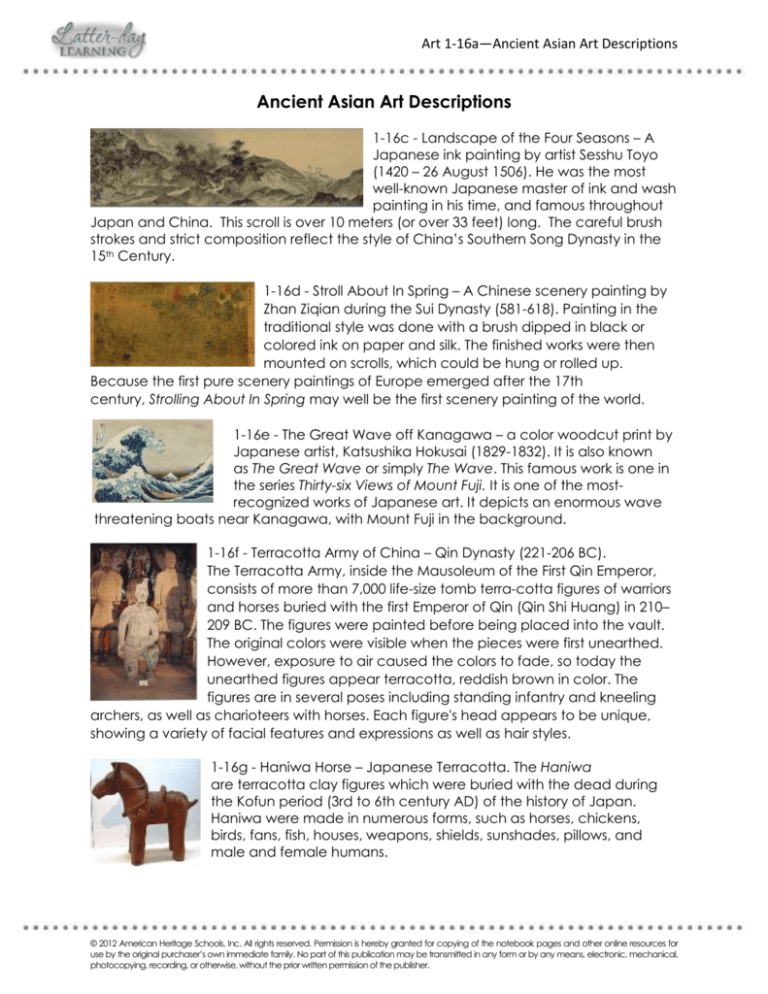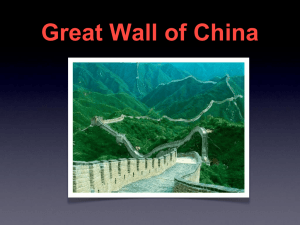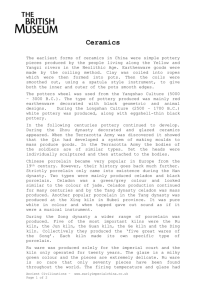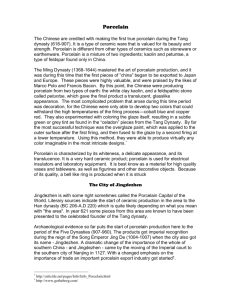
Art 1-16a—Ancient Asian Art Descriptions
Ancient Asian Art Descriptions
1-16c - Landscape of the Four Seasons – A
Japanese ink painting by artist Sesshu Toyo
(1420 – 26 August 1506). He was the most
well-known Japanese master of ink and wash
painting in his time, and famous throughout
Japan and China. This scroll is over 10 meters (or over 33 feet) long. The careful brush
strokes and strict composition reflect the style of China’s Southern Song Dynasty in the
15th Century.
1-16d - Stroll About In Spring – A Chinese scenery painting by
Zhan Ziqian during the Sui Dynasty (581-618). Painting in the
traditional style was done with a brush dipped in black or
colored ink on paper and silk. The finished works were then
mounted on scrolls, which could be hung or rolled up.
Because the first pure scenery paintings of Europe emerged after the 17th
century, Strolling About In Spring may well be the first scenery painting of the world.
1-16e - The Great Wave off Kanagawa – a color woodcut print by
Japanese artist, Katsushika Hokusai (1829-1832). It is also known
as The Great Wave or simply The Wave. This famous work is one in
the series Thirty-six Views of Mount Fuji. It is one of the mostrecognized works of Japanese art. It depicts an enormous wave
threatening boats near Kanagawa, with Mount Fuji in the background.
1-16f - Terracotta Army of China – Qin Dynasty (221-206 BC).
The Terracotta Army, inside the Mausoleum of the First Qin Emperor,
consists of more than 7,000 life-size tomb terra-cotta figures of warriors
and horses buried with the first Emperor of Qin (Qin Shi Huang) in 210–
209 BC. The figures were painted before being placed into the vault.
The original colors were visible when the pieces were first unearthed.
However, exposure to air caused the colors to fade, so today the
unearthed figures appear terracotta, reddish brown in color. The
figures are in several poses including standing infantry and kneeling
archers, as well as charioteers with horses. Each figure's head appears to be unique,
showing a variety of facial features and expressions as well as hair styles.
1-16g - Haniwa Horse – Japanese Terracotta. The Haniwa
are terracotta clay figures which were buried with the dead during
the Kofun period (3rd to 6th century AD) of the history of Japan.
Haniwa were made in numerous forms, such as horses, chickens,
birds, fans, fish, houses, weapons, shields, sunshades, pillows, and
male and female humans.
© 2012 American Heritage Schools, Inc. All rights reserved. Permission is hereby granted for copying of the notebook pages and other online resources for
use by the original purchaser’s own immediate family. No part of this publication may be transmitted in any form or by any means, electronic, mechanical,
photocopying, recording, or otherwise, without the prior written permission of the publisher.
Art 1-16a—Ancient Asian Art Descriptions
1-16h - Jade Dragon – Carving from the Western Han Dynasty (202 BC –
9 AD). In the history of the art of the Chinese empire, jade has had a special
significance, comparable to that of gold and diamonds in the West. Jade
was used for the finest objects and grave furnishings for high-ranking
members of the imperial family.
1-16i - Vase of a thousand Cranes – Korean, Goryeo Dynasty (918-1392).
National Treasure of Korea No. 68. Celadon originated in China, but
Korean potters created their own unique style of pottery that was so
valued that the Chinese considered it “first under heaven.” The Korean
celadon had a unique glaze known as “king-fisher” color, an iron based
blue-green glaze. They also displayed organic shapes and free-flowing
style, such as pieces that look like fish, melons, and other animals. Koreans invented an
inlaid technique known as sanggam, where potters would engrave semi-dried pottery
with designs and place materials within the decorations with black or white clay. The
white cranes here are made with this inlaid technique.
1-16j - Goldfish Vase – Chinese Porcelain, Ming Dynasty (1368-1544).
The Ming Dynasty is most well-known for its ceramic expertise and
craftsmanship. Artists discovered new techniques in design and shape.
The designs developed bright colors for the hand painted decoration
and the shapes became free-formed. Porcelain was mixed with
stronger clays to become whiter and stronger. The popularity of Ming
porcelain brought on the nickname of ‘china’ for these much sought
after vases and dishes.
1-16k - Chinese Celadon Vase with Two Dragon Handle – Chinese celadon
porcelain, Song Dynasty (960 to 1279 AD). This Chinese example of
celadon shows an almost white-green color. The handles seem very
delicate compared with the size of the vase. The belly of the vase is
intricately carved with flying dragons in the clouds; and there are
geometric patterns along the neck of the vase.
1-16l - Chinese mountain range lid jar – A celadon pot from the
Chinese Han Dynasty (202BC-220 AD). The lid is shaped as a
mountain range with animal designs of tigers and other animals as
well as door knockers along its side, and three footed supports. It is
found in the Cernuschi Museum, Paris, France.
© 2012 American Heritage Schools, Inc. All rights reserved. Permission is hereby granted for copying of the notebook pages and other online resources for
use by the original purchaser’s own immediate family. No part of this publication may be transmitted in any form or by any means, electronic, mechanical,
photocopying, recording, or otherwise, without the prior written permission of the publisher.












